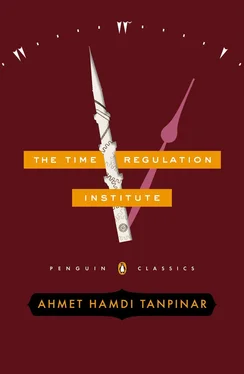Just as a watch can become a man’s dearest friend, ticking with the pulse in his wrist, sharing the passions in his chest, and growing heated with the same fervor, until they are as one, so too may a clock sit on a table throughout the span of time we call a day and assume the essence of its owner, thinking and living as he does. Without going into too much detail, I can say that we find this same tendency — to assimilate and adapt — in all our personal belongings, even if our relationships with them may never be as profound as the ones we have with our watches and clocks. Do not our old hats and shoes and clothes become more and more a part of us with the passage of time? Isn’t that why we are constantly trying to replace them? A man who dons a new suit leaves his old self behind. How different it looks, as it recedes in to the past! What bliss to exclaim, “I am at last a new man!”
I can assure you that the late Halit Ayarcı—who harbored the fear that many would come forward to discredit our institute — strongly recommended that I avoid making these types of declarations; but since I am no longer thus constrained, I can claim comfortably that it is indeed possible to see in an old hat or a pair of shoes all the whims of its owner — his foibles and particularities, even his many pains and sorrows. This may help explain the conventional wisdom that new servants coming to work in our homes should be given some of our clothes — at the very least a couple old shirts, a tie, or a pair of old shoes. Thus the servant — someone with whom we are newly acquainted — will, after putting on a shirt and tie and walking about in our shoes for a while, feel mysteriously compelled to adopt our idiosyncrasies and manners of thought, without ever knowing why. I myself experienced something like this on two occasions.
Cemal Bey, the director of the Bank of Diverse Affairs, and the man behind my dismissal from this establishment, was the architect of many of the calamities I’ve suffered in my life. There was a time when he offered me one of his suits. We had dramatically different personalities: he was a fussy, snobbish, grouch of a man, who judged the world by unbending rules and took great delight in belittling his staff, whereas I had a simple and compliant nature, wishing only to get by. The fact of the matter is that I never did take on his personality. That was beyond the realm of possibility. But his only weakness — his ardent love for his wife — seemed to have seeped into me through his suit. For during the week I wore that suit, I fell madly in love with Selma Hanım — I, a strict adherent to Muslim morals, father of three children, and married to Pakize, a woman far superior to me in every conceivable way. Years after I left the bank, the suit became tattered and threadbare. But my passion for Selma Hanım never waned.
The second suit was given to me by Halit Ayarcı, in the days just following the founding of our institute. He considered it best for me not to report to the institute in the clothes I was accustomed to wearing at that time. On the very first day I wore the suit, I sensed a dramatic shift in my entire being. New horizons and perspectives suddenly unfurled before me. Like Halit Ayarcı, I began to perceive life as a single entity. I began to use terms like “modification,” “coordination,” “work structure,” “mind-set shift,” “metathought,” and “scientific mentality”; I took to associating such terms as “ineluctability” or “impossibility” with my lack of will. I even made imprudent comparisons between East and West, and passed judgments whose gravity left me terrified. Like him, I began to look at people with eyes that wondered, “Now, what use could he be to us?” and to see life as dough that could be kneaded by my own two hands. In a word, it seemed as if his courage and powers of invention had been transferred to me, as if it were not a suit at all but a magic cloak. In fact I no longer saw Cemal Bey’s wife, Selma Hanımefendi, as a woman beyond my reach. Naturally all this didn’t develop as smoothly as it would have for Halit Ayarcı. Every so often my soft, complacent, compassionate nature — made softer over time by poverty and despair — would step in to interrupt and alter my course. In effect I became a man whose thoughts, decisions, and speech patterns were all in a jumble. When the late Halit Ayarcı heard me say as much, he smiled warmly and reassured me, “That’s just how it should be. It adds a certain spice. Keep it up!”
I feel I must stop here to report what was said on one of the days we discussed the matter.
“Aziz Hayri Irdal,” he declared, “what you have said is entirely true. This is precisely why all great men give their clothes and personal effects to those working alongside them. Roman emperors, kings, and powerful dictators have always presented their belongings to their friends so they might think as they do. Indeed this must be the very reason Ottoman leaders would bestow their kaftans and furs on their grand viziers. You have unwittingly put your finger on one of history’s great secrets, a kind of psychological mechanism!”
Without a doubt, he spoke the truth. And let us not forget that I made this discovery after putting on his suit. Yes, it was by donning his suit that I discovered this man had a genius for discovery.
But let us return to watches and clocks. Allow me to speak of The Psychoanalysis of Clocks , a seminal study first published by Dr. Ramiz in our institute’s journal. On second thought, I fear that such digressions — even if they are of an entirely scientific nature, or of a radically different nature, for that matter — will weigh too heavily upon these memoirs, and so I shall refrain. The work is in print, and those interested may consult it if they wish.
Dr. Ramiz and I differ in one significant respect, and here I shall relate what he said to me only personally: While I approached our joint enterprise from the perspectives of general psychology and sociology, he availed himself of such concepts as sexuality, libido, and repression. I was pleased to hear this, even though I knew nothing of individual or collective psychology, and even less of sociology. As he summed up his thoughts, Dr. Ramiz, who had always been kind enough to take me seriously, took the trouble to tell me that I was a great idealist. When my wife and I later discussed the matter, she was of the opinion that — seeing as we were speaking of subjects so intimately linked to human affairs as clocks, watches, and time — my utter disregard for the role of sexuality in the social realm could not be attributed to the so-called idealism the doctor saw in me but must stem from sources far more serious: namely corporeal and hygienic.
However you look at the situation, there is undeniably a difference between fast and slow timepieces, and this difference is an extremely important one. Therefore everyone found it quite acceptable when we enforced a two-kurus increase on the cash fine we collected for slow clocks and watches. In fact people were extremely pleased. And seeing as we fined those whose timepieces were slow, we were obliged to cede a certain advantage to those whose were running fast. Humanity never did sit easily with pure equality, and people need the encouragement of a little incentive here and there. I can say with confidence that good is only ever achieved if an identifiable evil is subjected to punishment and shame. My late teacher Nuri Efendi, whom I will discuss at length in due course, spoke these very words with regard to Sufism: “A thing is possible and accepted only if its opposite also exists.” In fact it was this important point that led Halit Ayarcı to agree to my proposed increase in fines.
The third particular of the system of fines I’d devised was a discount offered to repeat offenders, ranging from 10 to 30 percent. You’re well aware that the punishment for a crime is greater on the second offense, as the laws and customs of the world require. This leads to a kind of standoff between the legislator and the offender, a digging in of heels.
Читать дальше












